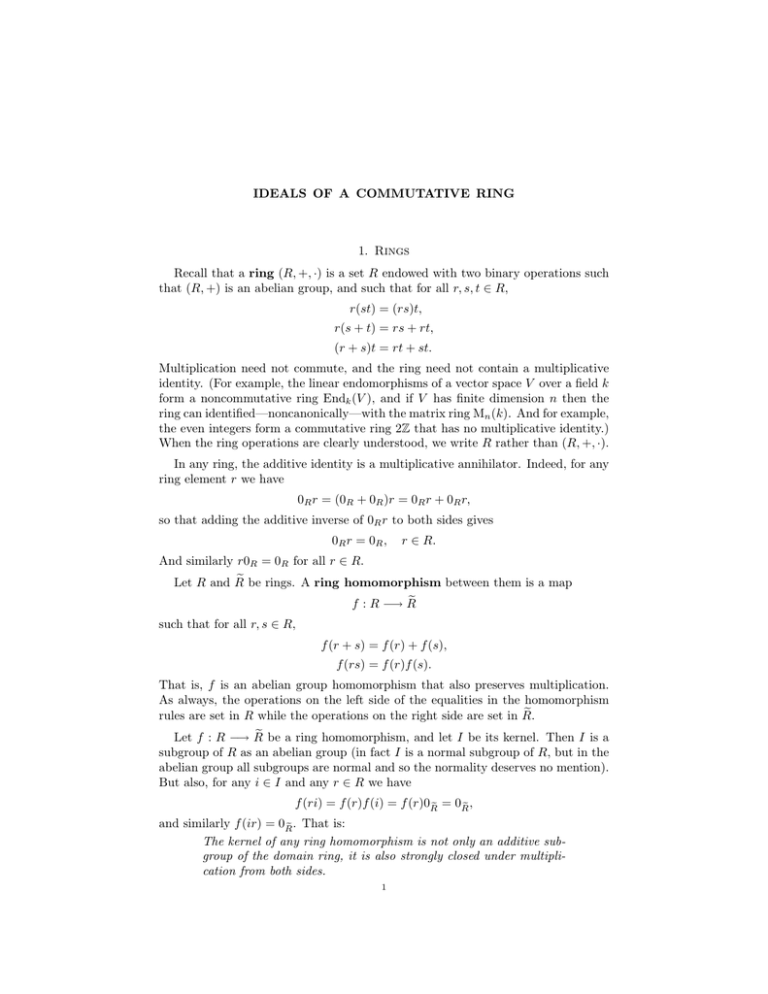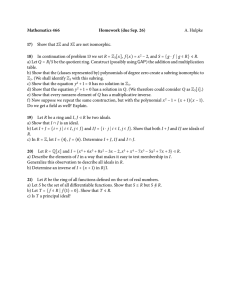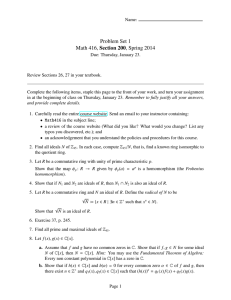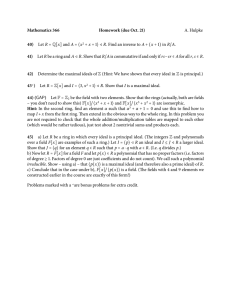IDEALS OF A COMMUTATIVE RING 1. Rings Recall that a ring (R, +
advertisement

IDEALS OF A COMMUTATIVE RING
1. Rings
Recall that a ring (R, +, ·) is a set R endowed with two binary operations such
that (R, +) is an abelian group, and such that for all r, s, t ∈ R,
r(st) = (rs)t,
r(s + t) = rs + rt,
(r + s)t = rt + st.
Multiplication need not commute, and the ring need not contain a multiplicative
identity. (For example, the linear endomorphisms of a vector space V over a field k
form a noncommutative ring Endk (V ), and if V has finite dimension n then the
ring can identified—noncanonically—with the matrix ring Mn (k). And for example,
the even integers form a commutative ring 2Z that has no multiplicative identity.)
When the ring operations are clearly understood, we write R rather than (R, +, ·).
In any ring, the additive identity is a multiplicative annihilator. Indeed, for any
ring element r we have
0R r = (0R + 0R )r = 0R r + 0R r,
so that adding the additive inverse of 0R r to both sides gives
0R r = 0R ,
r ∈ R.
And similarly r0R = 0R for all r ∈ R.
e be rings. A ring homomorphism between them is a map
Let R and R
e
f : R −→ R
such that for all r, s ∈ R,
f (r + s) = f (r) + f (s),
f (rs) = f (r)f (s).
That is, f is an abelian group homomorphism that also preserves multiplication.
As always, the operations on the left side of the equalities in the homomorphism
e
rules are set in R while the operations on the right side are set in R.
e be a ring homomorphism, and let I be its kernel. Then I is a
Let f : R −→ R
subgroup of R as an abelian group (in fact I is a normal subgroup of R, but in the
abelian group all subgroups are normal and so the normality deserves no mention).
But also, for any i ∈ I and any r ∈ R we have
f (ri) = f (r)f (i) = f (r)0Re = 0Re ,
and similarly f (ir) = 0Re . That is:
The kernel of any ring homomorphism is not only an additive subgroup of the domain ring, it is also strongly closed under multiplication from both sides.
1
2
IDEALS OF A COMMUTATIVE RING
Thus a kernel is a subring, but it has even stronger closure properties than a
general subring. The phenomenon is in close analogy to how any kernel of a group
homomorphism is not only a subgroup of the domain group but is in fact a normal
subgroup. By analogy to groups, we suspect that
• The quotient space of a ring by a kernel again has the structure of a ring.
• Any subring with the stronger closure properties allows the formation of
such a quotient and is a kernel.
e is a ring homomorphism
• (First Ring Isomorphism Theorem) If f : R −→ R
then it induces a natural isomorphism
∼
f˜ : R/ ker(f ) −→ im(f ), r + ker(f ) 7−→ f (r).
Indeed all three suppositions are correct, as we will see.
2. Ideals and Quotients
Again let R be a ring. Let I ⊂ R be a subring.
The resulting set of I-cosets,
R/I = {r + I : r ∈ R},
is perfectly sensible, and the only natural ring operations for R/I could be those
inherited from R,
(r + I) + (s + I) = r + s + I,
(r + I)(s + I) = rs + I.
Granting these operations, the ring axioms for R/I will follow from the ring axioms
for R. For example, the calculation
(r + I)(s + I) (t + I) = (rs + I)(t + I)
= (rs)t + I
= r(st) + I
= (r + I)(st + I)
= (r + I)( s + I)(t + I)
shows that associativity is inherited. But as always:
The question is whether the operations are well-defined.
Since the ring R is an abelian group under addition, the subring I is a normal
subgroup under addition, and so the addition operation on the quotient space poses
no problem. But the multiplication operation requires more scrutiny. Compute that
(r + I)(s + I) = rs + rI + Is + II.
Since I is a subring we have II ⊂ I. (But they may not be equal, since the subring I
need not contain 1; indeed, even the full ring need not contain a multiplicative
identity.) So in fact we have
(r + I)(s + I) ⊂ rs + rI + Is + I.
But now, in order to continue, we must assume that the subring I is in fact strongly
closed under multiplication,
rI ⊂ I and Ir ⊂ I
for all r ∈ R.
IDEALS OF A COMMUTATIVE RING
3
Such a subring has its own name:
Definition 2.1 (Ideal). Let R be a ring. An additive subgroup I of R that is also
strongly closed under multiplication is called an ideal of R.
Granting that the subring I is an ideal, we now have
(r + I)(s + I) ⊂ rs + I.
That is:
If the subring I of R is an ideal then the set (r + I)(s + I) is
a subset of the coset rs + I. Thus we should define the coset
product (r + I)(s + I) to be the full coset rs + I.
Contrast this with the situation for groups. If G is a group and N is a normal
subgroup then the relation
gN · g 0 N = gg 0 N
(equality of subsets of G)
must also be the formula for coset multiplication,
gN · g 0 N = gg 0 N
(product of cosets in G/N ),
but if R is a ring and I is an ideal then we have only
(r + I)(s + I) ⊂ rs + I
(containment of subsets of R),
but still the containment forces the rule
(r + I)(s + I) = rs + I
(product of cosets in R/I).
Although we have deduced that the coset multiplication rule for R/I has a chance
to be well-defined only if I is an ideal, we haven’t yet shown that if I is an ideal
then the coset multiplication rule really is well-defined. What needs to be shown
is that
r+I =ρ+I
=⇒ rs + I = ρσ + I.
s+I =σ+I
Equivalently, what needs to be shown is that
ρ−r ∈I
=⇒ ρσ − rs ∈ I.
σ−s∈I
But indeed,
ρσ − rs = ρσ − rσ + rσ − rs = (ρ − r)σ + r(σ − s),
and the right side of the display lies in I since ρ − r and σ − s do and since
I is an ideal. Note how the argument requires that I be strongly closed under
multiplication from both sides.
To summarize the discussion: Let R be a commutative ring, and let I ⊂ R be
an ideal. Then the quotient space of I-cosets in R,
R/I = {r + I : r ∈ R},
is again a ring under the natural definitions of addition and multiplication,
(r + I) + (s + I) = r + s + I,
(r + I)(s + I) = rs + I.
4
IDEALS OF A COMMUTATIVE RING
The ring R/I is called the quotient ring of R by I. And I is the kernel of the
natural projection map
R −→ R/I, r 7−→ r + I.
So indeed every ideal is a kernel, just as every kernel is an ideal.
The first isomorphism theorem for rings is proved exactly as it is proved for
groups.
3. Maximal Ideals and Prime Ideals
Definition 3.1 (Maximal Ideal, Prime Ideal). Let R be a ring. Then:
• An ideal I of R is maximal if the only ideal of R properly containing I is
R itself.
• An ideal I of R is prime if
for all r, s ∈ R,
rs ∈ I =⇒ r ∈ I or s ∈ I.
Now we add the hypothesis that R is a commutative ring with multiplicative
identity. That is, rs = sr for all r, s ∈ R, and R contains an element 1 such that
1r = r for all r ∈ R. Note that now an ideal of R is all of R if and only if contains 1.
Let I be an ideal of R. The condition that
I is maximal
is equivalent to the condition (letting the symbol r denote a ring element)
for all r ∈
/ I,
the ideal hr, Ii is all of R,
which in turn is equivalent to
for all r ∈
/ I,
rs + i = 1 for some s ∈ R and i ∈ I,
or,
for all r ∈
/ I,
rs + I = 1 + I for some s ∈ R,
or,
for all nonzero r + I ∈ R/I,
(r + I)(s + I) = 1 + I for some s + I ∈ R/I,
or,
R/I is a field.
Similarly, the condition
I is prime
is equivalent to the condition (letting the symbols r, s denote ring elements)
for all r, s ∈
/ I,
also rs ∈
/ I,
which in turn is equivalent to
for all nonzero r + I, s + I ∈ R/I,
also (r + I)(s + I) is nonzero in R/I,
or, recalling that a commutative ring with multiplicative identity is an integral
domain if it contains no zero-divisors,
R/I is an integral domain.
Since every field is an integral domain but not necessarily conversely, we have proved
the following result.
Proposition 3.2. Let R be a commutative ring with multiplicative identity. Let I
be an ideal of R. Then
IDEALS OF A COMMUTATIVE RING
5
• The ideal I is maximal if and only if the quotient ring R/I is a field.
• The ideal I is prime if and only if the quotient ring R/I is an integral
domain.
• If the ideal I is maximal then it is prime, but not necessarily conversely.
A slightly tricky feature of the language is that
• At the level of ring elements, prime and not zero-divisor implies irreducible.
• But at the level of ring ideals, maximal implies prime.
The issue is that although ideals can be multiplied, the multiplication of ideals
closely reflects the multiplication of ring elements only when the ideals are principal.
Here are some examples to illustrate how the definitions interplay.
(1) In a principal ideal domain, if an element r is irreducible then the ideal (r) is
maximal. Indeed, if r generates a non-maximal ideal then there exist proper
containments (r) ⊂ (s) ⊂ R. Thus r = st where neither s nor t is associate
to 1. That is, r is not irreducible. The result follow by contraposition.
(2) However, in the non-PID R = Z[X], consider a rational prime p ∈ Z. Then
p is irreducible in R, but the ideal (p) is not maximal because the ideal
I = hp, Xi properly contains it without being all of R.
(3) No longer assuming a PID, if (r) is maximal and r does not divide 0 then
r is irreducible. Indeed, if (r) is maximal then by the second bullet (r) is
prime, and so, since multiplication of principal ideals mirrors multiplication
of ring elements up to units (multiplicatively invertible elements, which we
don’t care about anyway), r is prime. If also r does not divide 0 then the
first bullet says that r is irreducible.
(4) However, in the ring Z/6Z, the element r = 3 + 6Z of the ring R = Z/6Z
generates a maximal ideal but is not irreducible since r = r2 . The issue is
that r is a zero-divisor.
4. The Quotient Field of an Integral Domain
Let R be an integral domain. Its quotient field is defined as follows. Consider
the set of ordered pairs from R whose second entry is nonzero,
{(r, s) : r, s ∈ R, s 6= 0}.
Define an equivalence relation on the set,
(r, s) ∼ (r0 , s0 )
if
rs0 = r0 s.
Then the quotient field is the set of equivalence classes,
QF(R) = {(r, s) : r, s ∈ R, s 6= 0}/ ∼,
endowed with the operations (using square brackets to denote equivalence classes)
[r, s] + [r0 , s0 ] = [rs0 + r0 s, ss0 ],
[r, s][r0 , s0 ] = [rr0 , ss0 ].
Purely formal verifications show that the operations are well-defined, that QF(R)
is a field, and that the map
R −→ QF(R),
r 7−→ [r, 1]
is a monomorphism of rings. The process is exactly the same as constructing the
field of rational numbers from the ring of integers and checking that the construction
6
IDEALS OF A COMMUTATIVE RING
is sensible. The usual notation for [r, s] is r/s, and the equivalence relation simply
encodes the usual cancellation rule for fractions.
5. Localization
Again let R be an integral domain. Let P be a prime ideal of R. The localization of R at P is a subring of the quotient field QF(R),
R(P ) = {[r, s] : r ∈ R, s ∈
/ P }.
The point is that (using the usual informal notation) if r/s and r0 /s0 have denominators not in P then so do r/s + r0 /s0 and r/s · r0 /s0 .
For example, localizing the basic integer ring Z at a prime ideal pZ gives the
ring Z(pZ) of rational numbers with denominators not divisible by p. The ideal
structure of the localized ring is very simple,
Z(pZ) ⊃ pZ(pZ) ⊃ p2 Z(pZ) ⊃ · · · .
Similarly, localizing the polynomial ring k[X] (where X is a field) at a prime ideal
(X −a)k[X] gives the ring k[X]((X−a)k[X]) of rational functions whose denominators
are not divisible by X − a. Again the ideal structure is simple,
k[X]((X−a)k[X]) ⊃ ((X − a)k[X])((X−a)k[X]) ⊃ (X − a)2 k[X]((X−a)k[X]) ⊃ · · · .







